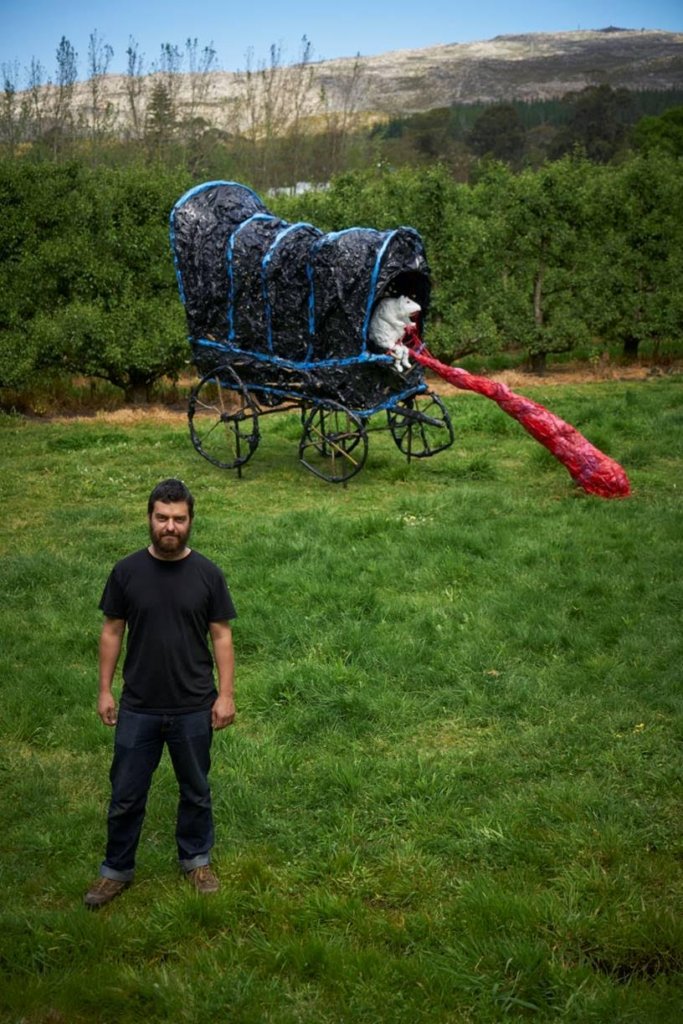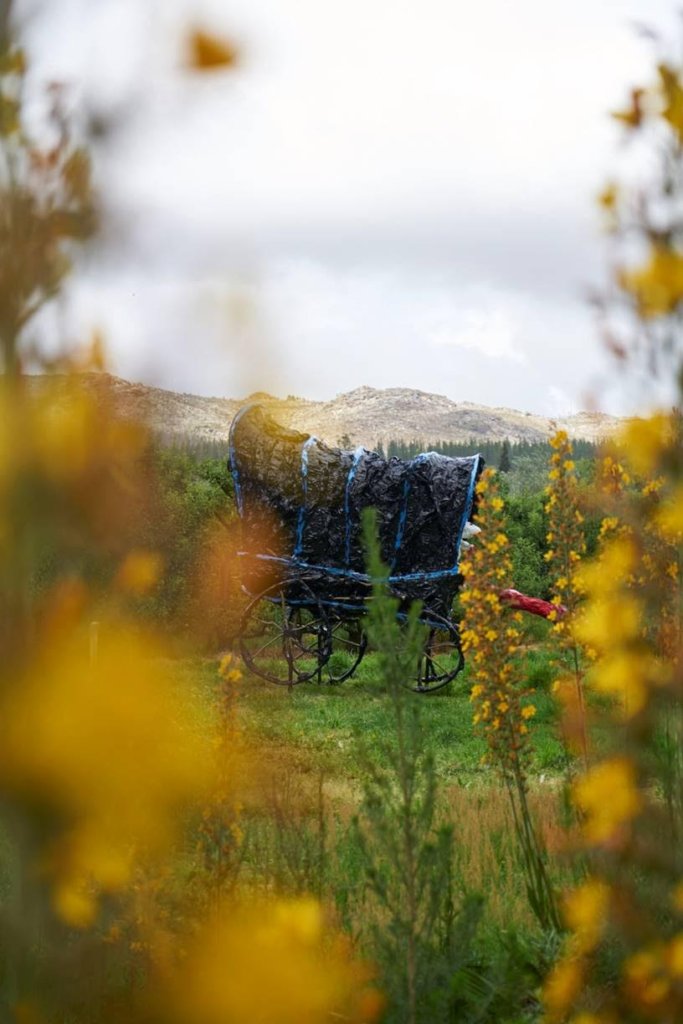Bloed Trek
‘My name is Ozymandias, King of Kings
Look at my works, Ye Mighty, and despair!’
Nothing beside remains round the decay
Of that colossal wreck, boundless and bare,
The lone and level sands stretch far away.
Percy Bysshe Shelley
Travelling through the Cape between 1811 and 1813 William Burchell bemoaned the barrenness of ‘a desolate wild and singular landscape. Clearly he was not thinking of Elgin. His Cape was a land ruinously sun-parched, without the balm of reflective watering holes, a limpid light, anything and everything that wasn’t geologically and meteorologically English. Indeed, Burchell would declare that ‘In Africa we look in vain for those mellow tints with which the sun dyes the forests of England’.
But as I sit in my Cape Dutch guest room, the shutters agape, in a balmy 32 degree heat, to my left I can see a blossoming blue-grey Robinia tree, beyond that a fauvist pink red and white daubed rose garden. Further still, by a narrow stream stand a naked couple sculpted by Wilma Cruise. Contemplative, each bowed in their own peculiar world, their mind’s eye drinking in a green escarpment bedecked by a mountain cocked like a jauntily crumpled hat. The scene is benign. Not all of this is man-made, nature is not always unforgiving, and Burchell should have plucked that mote from his jaundiced eye.

I am here at the Wildekrans Country House to speak to a sculpture by Francois Knoetze. A macabre reworking of the archetypal, even mythic, ossewa or ox-wagon, the accurately scaled work comprises a skeleton made of alien wood and black irrigation piping, and a skin of recycled black, red, and blue plastic. An allusion to the Great Trek, the Dutch venture inland in search of a new world, the sculpture, however, also speaks to the bloody cost of such self-determination, baring testimony, for Knoetze, to ‘the brutal and often romanticised history of Dutch pastoral expansion’.
On examining the sculpture one can see the graphic illustration of a violence, both psychic and physical, which shaped a cripplingly exacting journey into the hinterland. A bizarre blood red ‘vascular tendril’ plunges into the ground, ‘extracting blood from a living breathing entity’, notes Knoetze. It is clear therefore that we are not dealing with a memorial, a work about the past, but one designed to fuse past and future in a vexed and morbidly violent present.
Suggestive of a succubus, some parasitic form, Knoetze’s ‘Bloed Trek’ reminds us of the complicity of the dead and the living, the distortions of history and the impact of these distortions upon our minds today. We know of the expropriation of land, the decimation of the KhoiSan, of slavery and indentured labour brought from the East, of racial supremacy, caste and custom, and how all of these elements remain critical today in the clarion call of the Black First, Land First movement.
It was not however the Dutch but the British who were vitally instrumental in the making of South Africa’s benighted history when, in 1913, through the Natives Land Act, they assigned 90% of the land to a white minority. This appallingly unequal distribution lies at the core of our on-going struggle today, and, in a sense, one cannot assess Knoetze’s Bloed Trek without also acknowledging this later intervention, because, for all the continued conflict between the Dutch and the English, theirs remains a marriage made in the hellish engine-room of the Natives Land Act.
Why, J.M. Coetzee wonders in White Writing, is there no black presence in colonial landscape painting? Because blackness exists as an absent-presence, because blackness could not be integrated into a world-view in which it is land, and land alone, that matters, a land destined through some God-given right to be controlled by the white man. Knoetze has inherited this grotesque mind-set and, throughout his oeuvre, seeks to foreground and redress an ethical wrong. Working with recycled materials, he ‘counteracts the disavowal and un-remembering inherent in the act of throwing away’, finds ‘a personal entanglement with the conditions of living and consuming in the city’. What motivates Knoetze is the dark realisation that at no point are we ever divorced from our actions, and that we are always culpable, complicit, inescapably implicated. There is no before and after but a continuum in which the cycle of use-abuse-expiration-reiteration repeats itself.
This view, which echoes Nietzsche’s ‘eternal recurrence’, suggests that there can be no end-point, no transcendental moment, no after-life – to life. The Judeo-Christian fantasy of life after death, a fantasy in which the last shall be first, is a fantasy of the slave noted Nietzsche. This too was the fantasy of the Great trek, for the search for redemption and self-determination came with a brutally chilling and bloody cost, the cost of apartheid, systemic proof of the horror that continues to stalk any exclusionary or absolutist vision.
If Knoetze’s works are ‘stories of privilege and waste, humanity and inhumanity’ it is because he recognises not the separation of these component parts but their irrevocable connectedness: We can only have our humanity because of our inhumanity, we can only have our privilege because of our blindness to poverty. Pitched always at a tipping point where Right confounds Wrong, in which the ethical mess of life boils over, Knoetze’s art, with its epic Brechtian strokes, is designed to entrap us in very lies we enshrine, live by, and pretend do not exist.

But what if the reasons we construct in order to survive the atrocity of our lives are nothing more than delusory, what if, after Nietzsche, ‘Everything becomes and recurs eternally – escape is impossible’? If this is so, if everything recurs, then there is no way we will ever alight upon some transcendent moment of liberation. Stuck on repeat, we advance, retreat, failing always to sustain the best in us. Such is the depth of our hatred of ourselves and our hatred of others, that, despite the grand humanocentric post-racial project – that chintzy throwaway rainbow nation rhetoric – we remain ‘today, as in the past,’ notes Richard Pithouse, ‘human beings become objects, either invisible or hyper-present, their faces distorted into caricature or worn into nothingness by the enduring weight of the economic, spatial and symbolic divisions of the world’.
This cool and withering objectification of others, this reduction of being into thing, value to waste, has always dogged South African culture. It is not a peculiarly Colonial or Apartheid enterprise, but one which, like Nietzsche’s monstrous return, is all too present today. The root of dehumanisation is nihilism, and, after Freud, the Death Instinct. It is this death instinct which lies at the core of our continued ‘economic, spatial and symbolic’ unrest, an instinct which Knoetze has placed at the forefront of his works. His Bloed Trek, a rite of passage both past and present, a ‘living breathing entity’, performs the banality of horror, but also its monstrous yet quirky oddity, for on peering into the wagon we see cartoon-like white bodies neither dead nor alive but zomboid, plugged intravenously to an unending flow of black blood.

J.M. Coetzee too recognised this infinite black resource, this blood bank, in his novel Age of Iron, in which his leading protagonist, a retired and dying UCT Classics professor, cannot shake the thought of scores of undead black bodies writhing just beneath the surface of the earth. It is this unnerving and disorienting sense of wrong-doing which Knoetze has made the crux of his art. In his addition to the Wildekrans Country House’s sculpture park, which, tellingly, abuts Strydom van der Merwe’s organic bridge, Knoetze has given us a demanding reckoning.
Children will love the cartoon-like gore, reminiscent of Adventure Time, adults, more chastely hypocritical, might baulk before the unseemly trashy materials Knoetze has used, the bloodied baring of private parts, or the work’s misshapen child-like quality, but then there is nothing sacred in the artist’s vision. Made on site in four days with the help of a local assistant, Algavia, Knoetze’s ossewa, pockmarked, squiggly, fragile, will have to suffer the brunt of weather and time. But then, it was never intended to be an immortal work. Recall, here, the mistaken hubris of Ozymandias. Nothing remains intact, everything changes, everything returns, repeated differently – always. Which is why Knoetze must demystify a myth, desacralize a genocidal religio-fascist fantasy, and do so in a manner and form as comically brittle as it is achingly earnest.